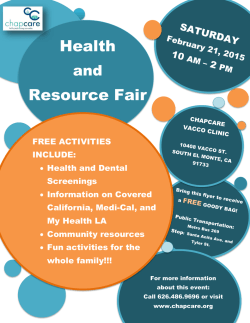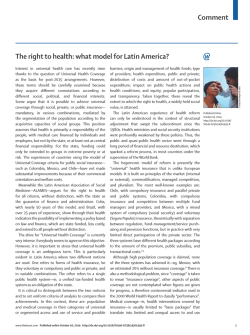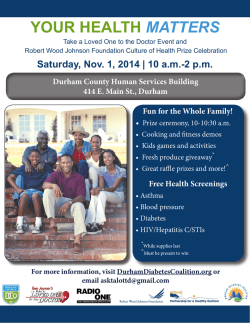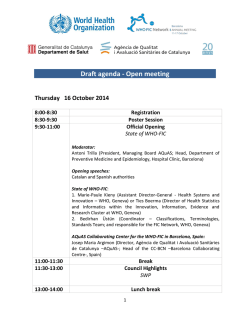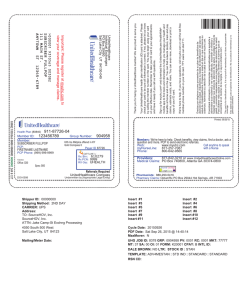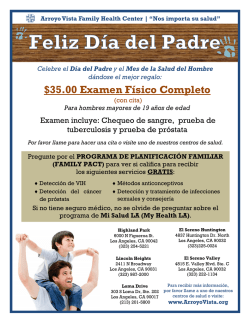
Chagas-Mazza disease
INFORMATION FOR PATIENTS Chagas-Mazza disease Enfermedad de Chagas- Mazza In 1909, Dr. Carlos Riveiro das Chagas discovered the disease in Brazil. In Argentina, Dr. Salvador Mazza, a pathologist, created the Argentine Regional Pathology Study Mission in Jujuy to identify and attend the sick. As a tribute, the disease was named after both of them. What is Chagas-Mazza disease and how do people get it? Chagas-Mazza disease is a rural disease associated with a poor social environment, caused by Tripanosoma cruzi, a parasite that lives and reproduces in bloodsucking triatomine bugs (kissing bugs). The disease, also known as American trypanosomiasis, is one of the most important endemic diseases in America. Where are triatomine bugs found? The bugs are found in houses within mud walls and thatched roofs, in crevices in the walls and roofs, behind the furniture and in poorly cleaned areas. Fig. 1. Picture of a triatomine bug How many people are infected? In Argentina, about 1,500,000 people are infected, and 20% of them will develop heart disease. It is estimated that as many as 6 million people are infected in America, 300,000 in the United States and 100,000 outside the continent, as a consequence of regional migrations. Author: Dr. Jorge Mitelman Full professor, IUCS Fundación HA Barceló Director of the Chagas Disease Council, SIAC How is Chagas-Mazza disease transmitted and what organs are affected? Triatomine bugs are insect vectors that carry the parasite and transmit it to animals and humans. After they bite, they defecate on the person causing itching; if the person accidentally scratches the feces into the bite wound, the parasite may enter the body. Pregnant women can transmit the disease to newborns and people can also get infected through blood transfusions, organ transplantation and accidental laboratory exposure. Domestic animals, such as dogs, cats and hens, can also get infected. The disease affects mainly the heart, but digestive organs and the nervous system can also be affected. How does the disease develop? Chagas-Mazza disease has an acute phase and a chronic phase. The acute phase can occur at the moment of inoculation. The chronic phase is initially asymptomatic, and then verifiable pathology develops in the heart (arrhythmias, heart failure), digestive organs (visceral enlargement, megaesophagus or megacolon) and in the nervous system. How is Chagas-Mazza disease detected? During the acute phase, direct methods detect the presence of Trypanosoma cruzi in the blood. In the chronic phase, the probability of finding the parasite in the circulation is low, and two out of three serological tests should be positive to make the diagnosis. How can Chagas-Mazza disease be prevented? Health promotion focuses on housing strategies, considering the following: • Eradicating adobe houses • Keeping the house clean (pictures and furniture) and sealing crevices • House spraying with insecticides • Keeping pets outside the house • Health promotion and education in big cities and rural areas • Control of pregnant women and newborns • Control of blood transfusions • Integral care of patients. Periodic control of chronic persons without v pathology REV ARGENT CARDIOL 2016;84:400. http://doi.org/10.7775/rac.v84.i4.9126 Editor: Julio Manuel Lewkowicz, MDMTSAC Sanatorio Güemes, Buenos Aires REFERENCES - Gimenez L, Mitelman J, Corvalán Oliver D, Lifschitz A, Mosca W. Enfermedad de Chagas Mazza en las grandes ciudades. Revista parasitológica al día (Federación Latinoamericana de Parasitología) Ed. Roemmers 2008:5-168. INFORMATION IN THE WEB - Ministerio de Salud. Programa Nacional de Chagas El Chagas en el país y Amé rica Latina http://www.msal.gob.ar/chagas/index.php/informacion-para-ciudadanos/el-chagas-en-el-pais-y-américalatina - Ministerio de Salud. Gobierno de la Ciu dad Autonoma de Buenos Aires - Direc ción de Programas Centrales. Dirección Redes Servicios de Salud.Policas Públi cas en Chagas. Programa de Chagas/ Red de Chagas. Anexo 2013:1-53 www. buenosaires.gob.ar/salud The information provided is intended to be informative and educational and is not a replacement for professional evaluation, advice, diagnosis or treatment by your healthcare professional. This page cannot be photocopied for commercial purposes, unless authorized by the Argentine Journal of Cardiology.
© Copyright 2024
